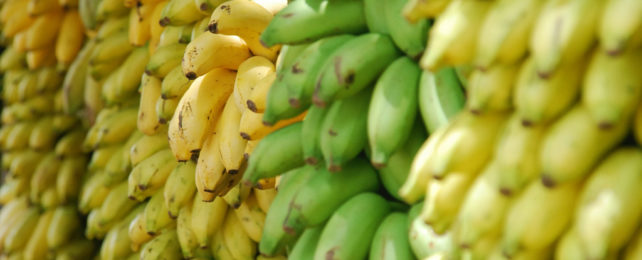The history of the banana is more complicated than you might have ever imagined (if you ever thought about it at all).
More than 7,000 years ago, Oceania communities began to selectively grow wild Musa acuminata plants for their choice characteristics. Over time the plant's fruit gradually evolved into the famous sweet, seedless, conveniently-packaged banana we've all come to love.
Unfortunately today, most of the bananas we consume are clones of a single variety. Without diverse genetic approaches to handling diseases, it wouldn't take much for a single plague to decimate the global supply.
A close look at the genomes of various banana cultivars and their wild relatives has now uncovered signs that other banana plant relatives contributed to its development, with evidence of three previously undescribed species or subspecies lurking within.
Learning more about them could give us new ways to protect existing cultivars from pests and infectious disease.
Different banana varieties can have two (referred to as diploid), three (triploid), or four (tetraploid) copies of every chromosome, making it more difficult to unravel the evoutionary history of the delicious grass-like flowering plant.
In this latest study, scientists used genetic sequencing techniques to identify the genetic fingerprints of 226 different banana leaf extracts. By comparing wild and domesticated subspecies, the team was able to build up a detailed 'family tree' of the ancestors of the bananas we have today.
"Here we show that most of today's diploid cultivated bananas that descend from the wild banana M. acuminata are hybrids between different subspecies," says genetic resources scientist Julie Sardos from the Alliance of Bioversity International and CIAT in France.
"At least three extra wild mystery ancestors must have contributed to this mixed genome thousands of years ago, but haven't been identified yet."
The researchers believe that two of these three mystery ancestors are the same as those which had previously been identified using a different genetic analysis approach, but now we have more information about these gaps in the banana tree family history, and where the common genomes are.
It means that there are banana species or subspecies out there that have never been recorded by scientists – although that doesn't necessarily mean none of those types of bananas remain.
"Our personal conviction is that they are still living somewhere in the wild, either poorly described by science or not described at all, in which case they are probably threatened," says Sardos.
The team then went further to try and figure out where these mysterious missing varieties might be growing, by making comparisons with similar banana species that we do know about and their respective locations around the globe.
One is likely to come from the area between the Gulf of Thailand and the west of the South China Sea, one is probably situated between north Borneo and the Philippines, and one looks like it came from the island of New Guinea.
The researchers say finding these missing ancestors is a matter of urgency – it will enable us to preserve the biodiversity that they offer, and ultimately enable better bananas to be cultivated in the future.
"Breeders need to understand the genetic make-up of today's domesticated diploid bananas for their crosses between cultivars, and this study is a major first step toward the characterization in great detail of many of these cultivars," says bioinformatics scientist Mathieu Rouard, also from the Alliance of Bioversity International and CIAT.
The research has been published in Frontiers in Plant Science.
